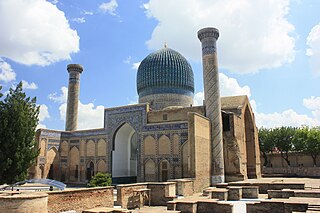
Les Invalides, formally the Hôtel national des Invalides, or also as Hôtel des Invalides, is a complex of buildings in the 7th arrondissement of Paris, France, containing museums and monuments, all relating to the military history of France, as well as a hospital and a retirement home for war veterans, the building's original purpose. The buildings house the Musée de l'Armée, the military museum of the Army of France, the Musée des Plans-Reliefs, and the Musée d'Histoire Contemporaine, as well as the Dôme des Invalides, a large church, the tallest in Paris at a height of 107 meters, with the tombs of some of France's war heroes, most notably Napoleon.

The Papal Basilica of Saint Peter in the Vatican, or simply Saint Peter's Basilica, is a church built in the Renaissance style located in Vatican City, the papal enclave that is within the city of Rome.

The Taj Mahal is an ivory-white marble mausoleum on the southern bank of the river Yamuna in the Indian city of Agra. It was commissioned in 1632 by the Mughal emperor Shah Jahan to house the tomb of his favourite wife, Mumtaz Mahal; it also houses the tomb of Shah Jahan himself. The tomb is the centrepiece of a 17-hectare (42-acre) complex, which includes a mosque and a guest house, and is set in formal gardens bounded on three sides by a crenellated wall.

Gol Gumbaz is the tomb of king Muhammad Adil Shah, Adil Shah Dynasty. Construction of the tomb, located in Vijayapura, Karnataka, India, was started in 1626 and completed in 1656. The name is based on Gola gummata derived from Gol Gombadh meaning "circular dome". It follows the style of Indo-Islamic architecture. Even a slight whisper by someone standing in its gallery can be heard everywhere else in the gallery, and if somebody claps, the sound of it echoes several times

The Gūr-i Amīr or Guri Amir is a mausoleum of the Turco-Mongol conqueror Timur in Samarkand, Uzbekistan. It occupies an important place in the history of Central Asian architecture as the precursor and model for later Mughal tombs, including the Gardens of Babur in Kabul, Humayun's Tomb in Delhi and the Taj Mahal in Agra, built by Timur's descendants. The mausoleum has been heavily restored.

Humayun's tomb is the tomb of the Mughal Emperor Humayun in Delhi, India. The tomb was commissioned by Humayun's first wife and chief consort, Empress Bega Begum, in 1558, and designed by Mirak Mirza Ghiyas and his son, Sayyid Muhammad, Persian architects chosen by her. It was the first garden-tomb on the Indian subcontinent, and is located in Nizamuddin East, Delhi, India, close to the Dina-panah Citadel, also known as Purana Qila, that Humayun found in 1533. It was also the first structure to use red sandstone at such a scale. The tomb was declared a UNESCO World Heritage Site in 1993, and since then has undergone extensive restoration work, which is complete. Besides the main tomb enclosure of Humayun, several smaller monuments dot the pathway leading up to it, from the main entrance in the West, including one that even pre-dates the main tomb itself, by twenty years; it is the tomb complex of Isa Khan Niyazi, an Afghan noble in Sher Shah Suri's court of the Suri dynasty, who fought against the Mughals, constructed in 1547 CE.

The Dome of Soltaniyeh in Soltaniyeh city, Zanjan Province, Iran, traditionally so called, is a complex of ruins centering on the Mausoleum of the Mongol ruler Il-khan Öljeitü, also known as Muhammad Khodabandeh.

The Mosque City of Bagerhat is a UNESCO World Heritage Site in Bagerhat District, Bangladesh. It contains several mosques built during the Bengal Sultanate in the 15th-century, of which the Sixty Dome Mosque is the largest. Other mosques include the Singar Mosque, the Nine Dome Mosque, the Tomb of Khan Jahan, the Bibi Begni Mosque and the Ronvijoypur Mosque. The mosques were built during the governorship of Ulugh Khan Jahan, a Turkic military officer appointed as governor in the Sundarbans by Sultan Mahmud Shah of Bengal.

Indo-Islamic architecture is the architecture of the Indian subcontinent produced by and for Islamic patrons and purposes. Despite an initial Arab presence in Sindh, the development of Indo-Islamic architecture began in earnest with the establishment of Delhi as the capital of the Ghurid dynasty in 1193. Succeeding the Ghurids was the Delhi Sultanate, a series of Central Asian dynasties that consolidated much of North India, and later the Mughal Empire by the 15th century. Both of these dynasties introduced Persianate, Turkic and Islamicate architecture and art styles from Western Eurasia into the Indian subcontinent.

The New Mosque (Turkish: Yeni Cami, Turkish pronunciation: [jeni dʒami], originally named the Valide Sultan Mosque and later New Valide Sultan Mosque after its partial reconstruction and completion between 1660 and 1665, is an Ottoman imperial mosque located in the Eminönü quarter of Istanbul, Turkey. It is situated on the Golden Horn, at the southern end of the Galata Bridge.

The Yeni Valide Mosque is an 18th-century Ottoman mosque in the Üsküdar district of Istanbul, Turkey.

Kotla Mubarakpur Complex, a medieval village, is now an upscale market place with a residential colony in South central part of New Delhi. The village Kotla Mubarakpur dominates Mahawar Koli of Rajput Samaj and Bainsla of Gurjar samaj in India. Classified by the Delhi Development Authority (D.D.A.) as an Urban Village, it is situated within touch of South Extension. Its main road connected opposite with Defence Colony. Nearest Delhi Metro station is South Extension, INA metro station and Lajpat Nagar. Its history can be traced to the prominent tomb of Muizud Din Mubarak Shah, son of Khizr Khan of the Sayyid dynasty of the fifteenth century Delhi Sultanate rule in India, and its adjoining mosque. There are several other tombs of Lodi Dynasty period such as the Darya Khan's tomb, Kale Khan ka Gumbad, Bare Khan ka Gumbad, Chote Khan Ka Gumbad and Bhure Khan ka Gumbad, and also a Baoli.

The Mausoleum of Ruhollah Khomeini, also referred to as the holy shrine, houses the tombs of the Ayatollah Ruhollah Khomeini, his wife Khadijeh Saqafi, and his second son Ahmad Khomeini; and some political figures, such as former President Akbar Hashemi Rafsanjani, former Vice President Hassan Habibi, Lieutenant General Ali Sayad Shirazi, Iranian Revolution figure Sadeq Tabatabaei, and MP Marzieh Hadidchi. The mausoleum is located to the south of Tehran in the Behesht-e Zahra cemetery. Construction commenced in 1989 following Khomeini's death on June 3 of that year. It is still under construction, but when completed will be the centerpiece in a complex spread over 20 square kilometres, housing a cultural and tourist center, a university for Islamic studies, a seminary, a shopping mall, and a 20,000-car parking lot. The Iranian government has reportedly devoted 2 billion US dollars to this development.

The Tomb of Mariam-uz-Zamani is the mausoleum of Mariam-uz-Zamani, the Queen consort of the Mughal Emperor Akbar. The tomb was built by Jahangir, in memory of his mother Mariam-uz-Zamani. The tomb is located in Sikandra, a suburb of Agra.

Shah-e-Alam's Tomb and Mosque, also known as Rasulabad Dargah or Shah Alam no Rozo, is a medieval mosque and tomb complex (Roza) in Shah Alam area of Ahmedabad, India.

Islamic rule in South Asia brought with it the use of domes constructed with stone, brick and mortar, and iron dowels and cramps. Centering was made from timber and bamboo. The use of iron cramps to join together adjacent stones was known in pre-Islamic India, and was used at the base of domes for hoop reinforcement. The synthesis of styles created by this introduction of new forms to the Hindu tradition of trabeate construction created a distinctive architecture.

Shish Gumbad, also spelt Shisha Gumbad, is a tomb from the Lodhi Dynasty and is thought to have possibly been constructed between 1489 and 1517 CE. The Shish Gumbad houses graves, whose occupants are not unequivocally identifiable. Historians have suggested, the structure might have been dedicated either to an unknown family, which was part of the Lodhi family and of Sikandar Lodi's court, or to Bahlul Lodi himself, who was chief of the Afghan Lodi tribe, founder and Sultan of the Lodi dynasty of the Delhi Sultanate.

Bara Gumbad is a medieval monument located in Lodhi Gardens in Delhi, India. It is part of a group of monuments that include a Friday mosque and the "mehman khana" of Sikandar Lodhi, the ruler of the Delhi Sultanate. The Bara Gumbad was constructed in 1490 CE, during the reign of the Lodhi dynasty. Its construction is generally attributed to Sikandar Lodhi, and it is believed to have the earliest constructed full dome of any building in Delhi.

The tomb of the noble Isa Khan Niazi is located in the Humayun's Tomb complex in Delhi, India. The mausoleum, octagonal in shape and built mainly of red sandstone, was built in 1547–1548 during the reign of Sher Shah Suri. The mosque of Isa Khan is located west of the mausoleum, which along with other buildings form the UNESCO World Heritage Site of Humayun's tomb complex.

The Tomb of Sayyid Hassan Modarres is the burial site of Sayyid Hassan Modares, former prime minister of Iran. It was built in 1937 in Kashmar, Iran, as opposed to using the former tomb of Kashmar in the vast gardens of Kashmar. The tomb building consists of a central dome, four dock and a dome made of turquoise, in the style of Islamic architecture and the Safavid dynasty. Seyed Hassan Modares lived during the Pahlavi dynasty and was from the Sadat of Tabatabai. He was a political constitutionalist. He was born in a village in Ardestan in 1870 and moved to Tehran and joined the second national legislature. In the year 1928, he was kept in secret and then exiled to Kashmar. He was one of those who opposed a republic because he believed in an Islamic Republic. In accordance with the law of interest and when Reza Shah thought that President Kemal Atatürk would bring the dreams to the King of Khan, eventually ended in 1937 in the city of Kashmar, representatives of Reza Shah killed.




















